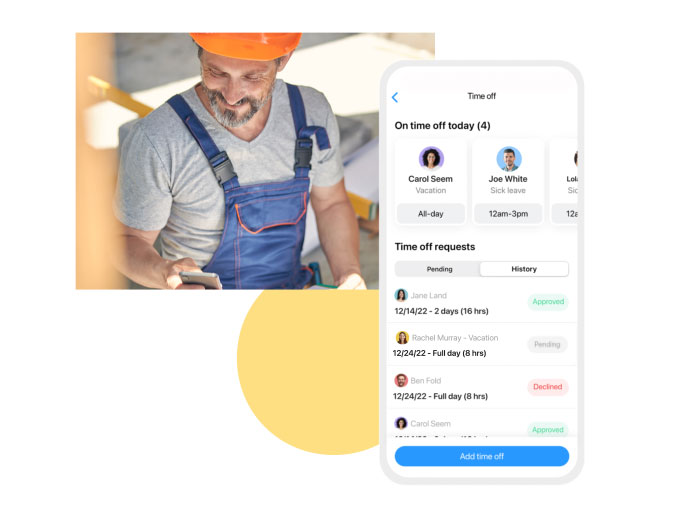Are you thinking about introducing paid leave or reviewing your existing policy? There is a range of considerations to take into account when doing so. For example, you need to decide how to include time off in employee work schedules and how vacation pay is earned. You also need to choose whether to offer separate paid leave for sick time or a pool of paid time off (PTO) days.
One of the hardest decisions is often how many days of paid vacation to offer employees. Offering too few can affect your employee’s morale. It can also increase turnover and make you an unappealing employer in the competitive talent market.
As a starting point, it’s helpful to look at the average number of vacation days per year for American workers. In this article, we take a closer look at paid vacation leave in the US—including average vacation days per year.
Numbers You Need to See:
- 28 million Americans don’t get any paid vacation or paid holidays (Zippia)
- In 2021, 33% of private industry employees received 10-14 days of paid vacation after one year on the job – this is considered the norm for most American businesses (U.S. Bureau of Labor Statistics)
- In 2022, more than half of Americans (55%) didn’t use all of their paid time off, which increased 27.8% from 2018 (Zippia)
- Around 54% of American workers with PTO used sick days to take a mental health day (Zippia)
- In 2022, less than half of hospitality workers had access to paid vacation leave (US Bureau of Labor Statistics)
What Is Paid Vacation?
Paid vacation days are days that an employee can take off from work and still get paid. Employees typically use these days to go on vacation, to rest, or for other personal reasons. The purpose of paid vacation leave generally doesn’t include sickness.
Paid vacation days are different from paid holidays. Paid holidays are specific state or national holidays that employees can take off and be paid for. Typical paid holidays include Memorial Day, Thanksgiving Day, and New Year’s Day.
There is also a difference between vacation days and paid time off. PTO is a broader term than vacation leave. Under a PTO—or a consolidated leave—plan, employers give employees a bank of paid days off for them to use as they wish.
So one employee could use their 20 days of PTO to take 10 vacation days and 10 sick days a year. Another employee could instead use theirs to take 19 vacation days and 1 sick leave day.
The #1 Time-Off Management Tool
Easily manage your employee’s work schedules and time off from anywhere with Connecteam.
Paid Vacation Leave in the US
The US is one of the few countries in the world that doesn’t require employers to offer paid time off. In fact, the US is the only OECD country without mandatory paid annual leave.
This is unusual when compared to the average paid vacation days per year in other countries.
- Australia: 4 weeks required by law
- United Kingdom: 5.6 weeks required by law
- Germany: 20 days minimum
- France: 5 weeks minimum
- Canada: 2 weeks after one year with the same employer
- Japan: 10 days after six months with the same employer
Did You Know?
Although it’s not a legal requirement, the majority of US employers give their employees paid vacation leave. This is typically either as a stand-alone policy or as part of a PTO policy. According to the US Bureau of Statistics, 79% of private industry workers receive paid vacation leave.
While there’s no federal law mandating paid vacation, employers still need to follow related regulations. The FLSA treats paid vacation as wages, and the FMLA lets (but doesn’t require) employees use vacation during unpaid leave.
Some states have their own regulations, including requiring payouts of unused time, restricting “use it or lose it” policies, and setting accrual limits. To stay compliant, employers should always document their policies, apply them consistently and uniformly, and honor any union agreements (if relevant).
Why Include Paid Vacation Time in Your Leave Policy?
If you’re on the fence about it, there are a range of reasons why you should include paid vacation leave in your PTO policy.
Firstly, it’s essential for supporting your employee’s physical and mental health. Everyone needs a break away from work to rest and for time with their friends and family. Without adequate time off, employees are at an increased risk of burning out.
Pro Tip
Manage PTO requests and approvals with Connecteam’s time off app. Employees can easily request time off, view remaining vacation days, and receive notifications, and you can keep track of it all on one single platform.
Get started with Connecteam for free today!

From an employee perspective, paid vacation leave is one of the most important benefits an employer can offer. In a 2020 survey by Unum, respondents identified generous paid time off as the top non-insurance benefit. Offering vacation leave helps you remain a competitive employer and attract the best candidates.
Finally, offering your employees vacation leave also benefits you as an employer. Time away from work allows your employees to rest and return to work refreshed, more productive, and more engaged. Employees are also likely to feel more loyalty to an organization that treats them well. This helps improve your employee retention rate.
What Is the Average Number of Vacation Days Per Year in the US?
According to the US Bureau of Labor Statistics (BLS), the average number of paid vacation days for private sector employees with one year of service is 11 days. Factoring in weekends, this works out to just over 2 full weeks of vacation leave per year.
Many employers increase the paid vacation leave offered to employees the longer they are with the company. For example, 15 days after 5 years, 18 after 10 years, and 20 days after twenty years of service.
The number of vacation days can vary by industry. BLS reports that nearly all (96%) workers in manufacturing, finance, and information sectors receive paid vacation, compared to 84% in education and health services, 79% in construction, and just 44% in leisure and hospitality.
There’s also a range when it comes to company size. In the private sector:
- 91% of companies with 500+ employees offer paid vacation.
- 70% of companies with 1–49 employees offer paid vacation.
- 76% of companies with 50–99 employees offer paid vacation.
- 88% of companies with 100–499 employees offer paid vacation.
Pro Tip
Make sure you fully understand your company’s PTO policy, as well as the various PTO Payout Laws By State.
What is Vacation Time Accrual?
Under a vacation accrual policy, employees earn a specific amount of vacation time per hour worked. This is instead of receiving vacation time upfront. For example, someone might accrue ~7 hours every month, instead of just receiving 88 hours at the start of the year.
To make this system work, you need to know the accrual rate, or the percentage of vacation time an employee earns for every hour worked. This lets you calculate the exact amount of time off an employee has earned at any given point in the year.
Here’s how to calculate it:
An employee works 40 hours a week, or 2,080 hours a year. The employer offers 11 paid vacation days a year, or 88 hours. For the hourly accrual rate, calculate:
(88 hours ÷ 2,080 hours) × 100 = 4.2% accrued vacation rate.
Now, you can use the rate to calculate how many paid vacation hours an employee will accrue per pay period. For example, if the pay period is 2 weeks (80 hours), they earn:
80 hours × 4.2% = 3.36 hours accrued per pay period.
Read next: How to Calculate Vacation Pay for Hourly Employees
Factors That Influence the Number of Vacation Days
The type of industry can influence whether or not an employee receives vacation days.
Leisure and hospitality workers are the least likely to receive paid vacation leave. Only 43% of employees in this industry receive paid vacation leave. This is compared to 95% in the manufacturing and financial activities sectors.
Larger companies are also more likely to offer their employees paid time off than small businesses. 92% of private industry workers in a business with 500 or more workers received paid vacation leave. This is compared to 71% in a business of 49 workers or less.
There are other factors you may need to consider when deciding the number of days to offer your employees for paid vacation leave. The nature of the work is one of these factors. A more intense work schedule or environment may warrant more paid vacation leave.
The average number of days your competitors offer for vacation leave is another relevant consideration.
Try the #1 all-in-one employee management app.
Manage your leave policies from a single, easy-to-use location.

Do Employees Use All of Their Vacation Leave?
Regardless of how many vacation days you offer your employees, they may not use them all. According to the US Travel Association, in 2018 more than 50% of American workers had unused vacation leave—totaling 768 million days.
Reports suggest this trend is changing. But it’s still important for employers to encourage their employees to use their vacation leave. Here’s why:
- For employees, unused vacation days can lead to burnout, higher stress levels, reduced job satisfaction, lower productivity, and a decline in work-life balance.
- For employers, unused vacation days can result in large payouts, lower performance, higher turnover, increased healthcare costs, and lower team morale.
To avoid these issues, here are some best practices to follow:
Create a clear vacation policy
Outline how vacation is earned, how it can be used, and any restrictions. Make sure the policy is precise. Once you’ve created the policy, go over it with your employees, make sure that they understand it, and keep it in accessible place (like your company knowledge base) for easy reference.
Set fair accrual rates and approval processes
Choose accrual rates that comply with labor laws and align with industry norms. Make sure you explain the process of how requests should be submitted, who approves them, and how quickly an employee can expect a response.
Schedule time off fairly
Create a structure for how to handle overlapping requests fairly. Consider requiring reasonable notice, or implementing first-come, first-served rules. What’s important is that employees view the process as fair and transparent.
Plan for coverage
Prepare for absences by cross training your staff and having backups in mind. You don’t want to be in a situation where all of your managers, say, are out on the same day. Share schedules well in advance so teams are prepared, and keep workloads balanced.
Track balances accurate
Use automated time off management software to calculate accruals, approve requests, and keep records updated. Make sure employees know how to access their balances, or give them regular updates so they know how much time they’ve earned.
FAQ
Are PTO and vacation the same?
PTO, or paid time off, and vacation are related but not the same. PTO is a term that includes vacation days, personal days, and sick days, allowing employees to use their allotted time off for any purpose. Vacation, however, specifically refers to days taken for leisure and relaxation. While all vacation days are a part of PTO, PTO encompasses more than just vacation, providing employees with more flexibility to manage their time off as needed.
What is the minimum number of vacation days in the US?
Surprisingly, the answer is zero. The US is one of the few countries without a federal policy mandating companies to provide employees with paid time off. The government leaves it up to each individual company to determine how many vacation days it wants to give its employees.
Do all employees receive paid vacation?
Not all employees receive paid vacation. In the United States, there is no federal mandate requiring companies to provide paid vacation days. The decision to offer paid vacation is typically left to individual employers, and the availability and amount of paid vacation can vary widely. Some employers offer generous vacation packages, while others may offer none.
What are the benefits of offering generous paid vacation time to employees?
Offering generous paid vacation time can improve employee morale, reduce burnout, and increase productivity. Positioning your company as supportive of work-life balance can also help attract and retain top talent.
What are some strategies for encouraging employees to use their vacation time?
Encourage your employees to use vacation time by leading by example, reminding employees of their balances, and making the approval process simple. Set clear vacation policies and stress the health benefits of taking regular breaks.
Are there any tax implications related to paid vacation days?
Yes. The tax implications of paid vacation days include treating them as taxable income. Employers need to report vacation pay as wages, and employees still need to pay income and payroll taxes on the earnings.
What are some alternatives to traditional paid vacation time?
Some alternatives to traditional paid vacation are unlimited PTO, flexible scheduling, mental health days, and unpaid leaves. These options tend to give employees more independence, and support rest and balance.
How does the US compare to other developed countries in terms of vacation time?
The U.S. generally offers less vacation than most other developed countries. For example, European nations mandate 20–30 annual paid days off, while the U.S. law requires none. The U.S. leaves time off to the employer’s discretion, with the average U.S. employee receiving about 10 paid days per year.
What are the best employee time-off management tools?
Connecteam is one of the best employee time-off management tools. It lets you track requests, balances, and approvals, while integrating with payroll providers and in-app features like scheduling, communication, and time tracking.



